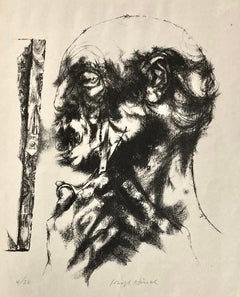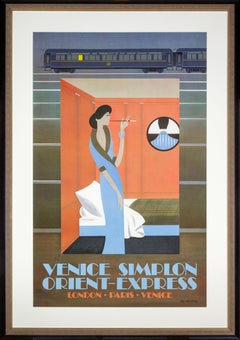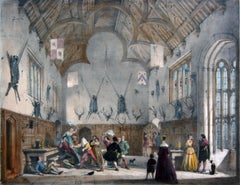Joseph Hirsch Interior Prints
American, 1910-1981
Joseph Hirsch was a member of the American Academy-Institute of Arts and Letters and a well-known realistic artist who came to national attention as a muralist for the Federal Works Progress Administration in the 1930's.
Of his own work, Mr. Hirsch wrote: ''I believe that some day the fabric of art will be threaded with morality, enabling us to distinguish evil from good. Today, this is unthinkable, in the delightful art world where, excepting censorship, anything goes. But anything goes does not accord with the more discriminating ethics of our civilized code which rules out what is socially destructive.''
Mr. Hirsch is represented in the Metropolitan Museum of Art, the Museum of Modern Art and the Whitney in New York; the National Gallery, the Corcoran and the Hirshhorn in Washington; the Boston Museum of Fine Arts, and in many major collections in the United States.
Joseph Hirsch was born on April 25, 1910 in Philadelphia, Pennsylvania. Hirsch studied at the Philadelphia Museum School, with Henry Hensche in Provincetown, Mass., and with George Luks in New York. In addition to formal study,
He participated in the Works Project Administration in the easel painting division, with occasional work in the mural division, where he painted murals in the Amalgamated Clothing Workers Building and the Municipal Court. During World War II, Joseph Hirsch took part in the war effort, as an artist war correspondent, recording significant battles and events.
He taught at the Chicago Art Institute, the American Art School, University of Utah, and had a significant tenure at the Art Students League in New York. He also won many awards, among them were a fellowship at the American Academy in Rome, the Walter Lippincott Prize, First Prize at the New York World's Fair (1939), the Guggenheim Foundation Fellowship (1942, 1943), and the Fulbright Fellowship (1949). In 1954 he was elected into the National Academy of Design as an Associate member and became a full Academician in 1958
Early in his career, Hirsch was introduced to the movement of Social Realism through George Luks, who was one of "The Eight". This group of painters, at the beginning of the century, chose to depict ordinary and everyday scenes. From this movement stemmed the Social Realism genre of the 1920s and 1930s. Social commentary was the backbone for the majority of Joseph Hirsch's paintings.
During World War II, Mr. Hirsch went to the South Pacific, North Africa and Italy as an artist-correspondent for the Navy, and his paintings and drawings are in the Museum of Military History. . In Major Collections. Hirsch's work is represented in the Metropolitan Museum of Art, the Museum of Modern Art and the Whitney in New York; the National Gallery, the Corcoran and the Hirshhorn in Washington; the Boston Museum of Fine Arts, and other collections in the USA. He was elected to membership in the National Institute of Arts and Letters in 1967. Hirsch died in New York, NY on September 21, 1981.to
1
Overall Width
to
Overall Height
to
21
108
76
32
30
1
1
1
1
1
1
1
1
Artist: Joseph Hirsch
Joseph Hirsch, (Cutting the Beard)
By Joseph Hirsch
Located in New York, NY
A man with lots of whiskers is trimming his facial hair while looking in a mirror. The male figure and his beard are carefully drawn but Hirsch has cleverly just briefly sketched in ...
Category
Mid-20th Century Ashcan School Joseph Hirsch Interior Prints
Materials
Lithograph
Related Items
"Orient Express, " Lithograph Poster by Pierre Fix-Masseau
By Pierre Fix-Masseau
Located in Milwaukee, WI
"Orient Express" is a lithograph poster by Pierre Fix-Masseau. The artist signed his name in the lower right of the image. This piece depicts a fashionable woman smoking in one of the rooms of the Venice Simplon...
Category
1980s Art Deco Joseph Hirsch Interior Prints
Materials
Lithograph
$3,625
H 37.69 in W 24.375 in
Mid 19thCent. Kings Hall Party Session, Athelhampton, Dorsetshire by Joseph Nash
By Joseph Nash
Located in Soquel, CA
Historical mid-19th century hand tinted lithograph and a lively scene of men and women engaging in a light hearted game of the era by artist Joseph Nash (British, 1808-1878). Signed ...
Category
Mid-19th Century Victorian Joseph Hirsch Interior Prints
Materials
Watercolor, Lithograph
$552 Sale Price
35% Off
H 27 in W 22 in D 2 in
Nude in Artist's Studio, Cubist Lithograph by Andre Minaux
By Andre Minaux
Located in Long Island City, NY
Artist: Andre Minaux, French (1923 - 1986)
Title: Nude in Artist's Studio
Year: circa 1970
Medium: Lithograph, signed and numbered in pencil
Edition: EA 40
Image Size: 22.5 x 16.5 i...
Category
1970s Cubist Joseph Hirsch Interior Prints
Materials
Lithograph
$800
H 22.5 in W 16.5 in
"Folding Linen III" - Limited Edition Lithograph, 20/75
Located in Soquel, CA
Beautiful figurative limited edition lithograph by Robert Baxter (American, b. 1933). Signed and numbered "R. Baxter 20/75" lower left. Displayed with wh...
Category
1980s Realist Joseph Hirsch Interior Prints
Materials
Paper, Lithograph
$2,047 Sale Price
35% Off
H 28.75 in W 40.5 in D 1 in
Plum Blossoms 1948, 1971, rare offset lithograph poster published in Switzerland
By Henri Matisse
Located in New York, NY
After Henri Matisse
Plum Blossoms, 1948, 1971
Offet lithograph poster
Offset lithograph poster
Published in Zurich Switzerland on the occasion of the exhibition "Twenty Important Pai...
Category
Mid-20th Century Modern Joseph Hirsch Interior Prints
Materials
Offset, Lithograph
Emilio Sanchez "Puerta en San Juan" Lithograph
By Emilio Sanchez
Located in New York, NY
Emilio Sanchez
Puerta en San Juan, c. 1965
Lithograph
Image: 21 1/2 x 13 1/4 in.
Sheet: 18 3/4 x 12 1/4 in.
Framed: 29 1/4 x 20 3/4 x 1 in.
Edition 17 of 50
Numbered, titled, and si...
Category
1960s Modern Joseph Hirsch Interior Prints
Materials
Lithograph
$1,200
H 29.25 in W 20.75 in D 1 in
College of Physicians, from Ackermann's "Microcosm of London."
By Thomas Rowlandson
Located in Middletown, NY
Pugin, Augustus Charles & Rowlandson, Thomas (after).
College of Physicians, from Ackermann's "Microcosm of London."
London: Rudolph Ackermann, 1808. Hand-colored lithograph, 9 1/4 ...
Category
Early 19th Century English School Joseph Hirsch Interior Prints
Materials
Handmade Paper, Watercolor, Lithograph
Original Wallpapers and Decorations John Gilkes & Sons vintage poster
Located in Spokane, WA
Wallpapers and Decorations John Gilkes & Sons. Original stone lithograph. Size: 31" x 47". C. 1915 - 1920. Printer: J.J. Keliher & Co., London Archival linen backed authentic antique poster...
Category
1910s Art Nouveau Joseph Hirsch Interior Prints
Materials
Lithograph
$798 Sale Price
20% Off
H 47 in W 31 in D 0.05 in
Interior of the Odeum of Pericles - Lithograph - 1862
Located in Roma, IT
Interior of the Odeum of Pericles is a lithograph on paper realized in 1862.
The artwork belongs to the Suite Uses and customs of all the peoples of the universe: " History of the g...
Category
1860s Modern Joseph Hirsch Interior Prints
Materials
Lithograph
Woman - Lithograph by Marcel Vertès - Mid-20th Century
By Marcel Vertès
Located in Roma, IT
Woman is original lithograph realized by Marcel Vertès in the mid-20th Century.
The artwork is in good condition.
Hand-signed.
The artwork is depicted...
Category
Late 20th Century Joseph Hirsch Interior Prints
Materials
Lithograph
$310
H 7.88 in W 13.78 in D 0.04 in
Bath in Algeria - Original Lithograph - 1846
Located in Roma, IT
Bath in Algeria is an original Hand-colored lithograph on paper realized in 1846 by an Anonymous artist of the 19th century.
Titled in Italian on the lower center.
The state of pr...
Category
1840s Joseph Hirsch Interior Prints
Materials
Lithograph
Conversation - Lithograph by Adolphe Albert - 20th Century
Located in Roma, IT
Conversation is an original lithograph artwork realized by Adolphe Albert (1855-1938). Signed on the plate,
The state of preservation is very good.
The artwork represents a convers...
Category
20th Century Modern Joseph Hirsch Interior Prints
Materials
Lithograph
$298
H 16.15 in W 11.82 in D 0.04 in
Joseph Hirsch interior prints for sale on 1stDibs.
Find a wide variety of authentic Joseph Hirsch interior prints available for sale on 1stDibs. You can also browse by medium to find art by Joseph Hirsch in lithograph and more. Not every interior allows for large Joseph Hirsch interior prints, so small editions measuring 11 inches across are available. Joseph Hirsch interior prints prices can differ depending upon medium, time period and other attributes. On 1stDibs, the price for these items starts at $750 and tops out at $750, while the average work can sell for $750.


